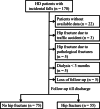Femoral artery calcification predicts hip fracture in maintenance hemodialysis patients
- PMID: 40781195
- PMCID: PMC12334447
- DOI: 10.1007/s11657-025-01536-1
Femoral artery calcification predicts hip fracture in maintenance hemodialysis patients
Abstract
Femoral artery calcification (FAC) is a significant predictor of hip fractures in hemodialysis patients. A higher FAC score is associated with increased fracture risk and poor survival outcomes. Identifying FAC through radiographic assessment may improve fracture risk stratification and clinical management in this high-risk population.
Purpose: Patients with end-stage renal disease (ESRD) on hemodialysis (HD) are at increased risk for vascular calcification (VC) and bone fractures. While previous studies have linked aortic calcification with hip fractures, the relationship between medium-caliber artery-femoral artery calcification (FAC) and fall-related hip fractures in HD patients remains unclear.
Methods: We retrospectively analyzed 170 HD patients who experienced falls and sought treatment in the emergency department (ED) between 2007 and 2014. The FAC score, representing the severity of femoral artery calcification, was calculated as the ratio of the total length of calcification plaques to the length of the femoral vessel visible on plain radiographs of the hip and femur. A logistic regression model assessed the association between FAC score and hip fracture risk, and receiver operating characteristic curve analysis evaluated its predictive power.
Results: Among the 130 patients meeting inclusion criteria, 55 had fall-related hip fractures. The incidence rate of hip fractures among dialysis patients was 6.18 cases per 1000 person-years by dividing the total number of hip fracture events by the cumulative dialysis duration (in years) of all enrolled patients. Fracture patients were older and had lower serum creatinine, sodium, and albumin levels but higher aspartate aminotransferase levels. The fracture group also had a higher FAC score (0.47 [IQR, 0.28 - 0.76] vs. 0.00 [IQR, 0.00 - 0.40], p < 0.001). Multivariable analysis identified old age, heart failure with reduced ejection fraction (EF), and higher FAC scores as independent risk factors for hip fractures. Survival curves showed increased mortality among patients with higher FAC scores and hip fractures (p < 0.01).
Conclusion: High FAC scores were associated with an increased risk of hip fractures in HD patients, independent of traditional risk factors, and were linked to poor survival outcomes.
Keywords: Dialysis; Femoral artery calcification; Hip fracture; Vascular calcification.
© 2025. The Author(s).
Conflict of interest statement
Declarations. Conflicts of interest: None.
Figures




Similar articles
-
Falls prevention interventions for community-dwelling older adults: systematic review and meta-analysis of benefits, harms, and patient values and preferences.Syst Rev. 2024 Nov 26;13(1):289. doi: 10.1186/s13643-024-02681-3. Syst Rev. 2024. PMID: 39593159 Free PMC article.
-
Are There Differences in Performance Among Femoral Stem Brands Utilized in Cementless Hemiarthroplasty for Treatment of Geriatric Femoral Neck Fractures?Clin Orthop Relat Res. 2025 Feb 1;483(2):253-264. doi: 10.1097/CORR.0000000000003222. Epub 2024 Aug 15. Clin Orthop Relat Res. 2025. PMID: 39158389
-
Phosphate binders for preventing and treating chronic kidney disease-mineral and bone disorder (CKD-MBD).Cochrane Database Syst Rev. 2018 Aug 22;8(8):CD006023. doi: 10.1002/14651858.CD006023.pub3. Cochrane Database Syst Rev. 2018. Update in: Cochrane Database Syst Rev. 2025 Jun 27;6:CD006023. doi: 10.1002/14651858.CD006023.pub4. PMID: 30132304 Free PMC article. Updated.
-
Comparison of Two Modern Survival Prediction Tools, SORG-MLA and METSSS, in Patients With Symptomatic Long-bone Metastases Who Underwent Local Treatment With Surgery Followed by Radiotherapy and With Radiotherapy Alone.Clin Orthop Relat Res. 2024 Dec 1;482(12):2193-2208. doi: 10.1097/CORR.0000000000003185. Epub 2024 Jul 23. Clin Orthop Relat Res. 2024. PMID: 39051924
-
What Is the Cumulative Incidence of Femoral Stem Revision and Stem Complication in Cemented and Uncemented Hip Arthroplasty for Proximal Femoral Metastatic Bone Disease?Clin Orthop Relat Res. 2025 Jun 10;483(9):1652-64. doi: 10.1097/CORR.0000000000003541. Online ahead of print. Clin Orthop Relat Res. 2025. PMID: 40522275
References
-
- Slouma M, Sahli H, Bahlous A et al (2020) Mineral bone disorder and osteoporosis in hemodialysis patients. Adv Rheumatol 60:15 - PubMed
-
- Alem AM, Sherrard DJ, Gillen DL, Weiss NS, Beresford SA, Heckbert SR, Wong C, Stehman-Breen C (2000) Increased risk of hip fracture among patients with end-stage renal disease. Kidney Int 58:396–399 - PubMed
-
- Perez-Saez MJ, Prieto-Alhambra D, Barrios C, Crespo M, Redondo D, Nogues X, Diez-Perez A, Pascual J (2015) Increased hip fracture and mortality in chronic kidney disease individuals: the importance of competing risks. Bone 73:154–159 - PubMed
MeSH terms
Grants and funding
LinkOut - more resources
Full Text Sources
Medical

